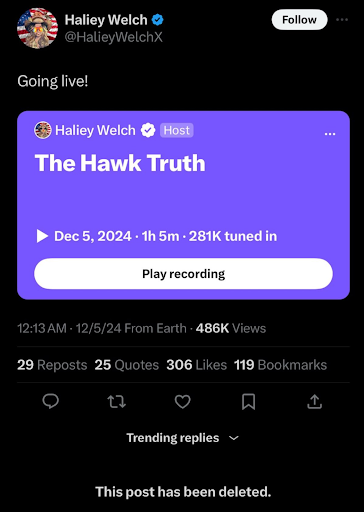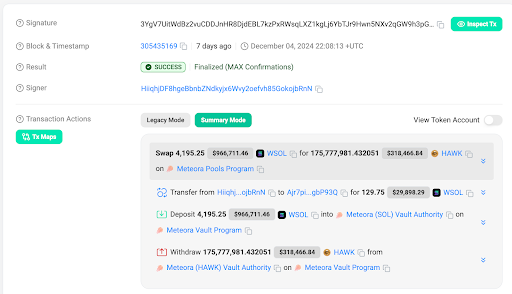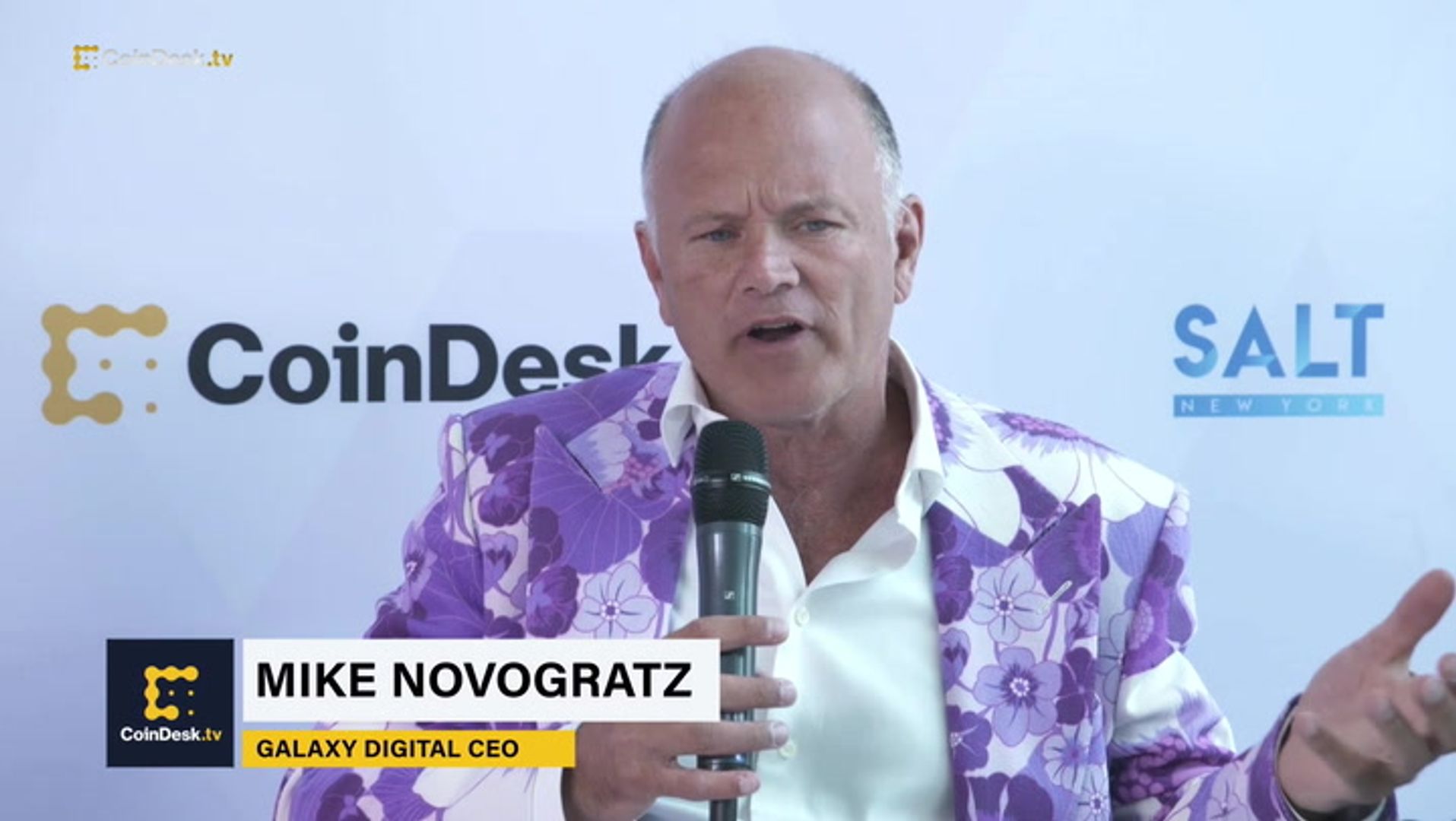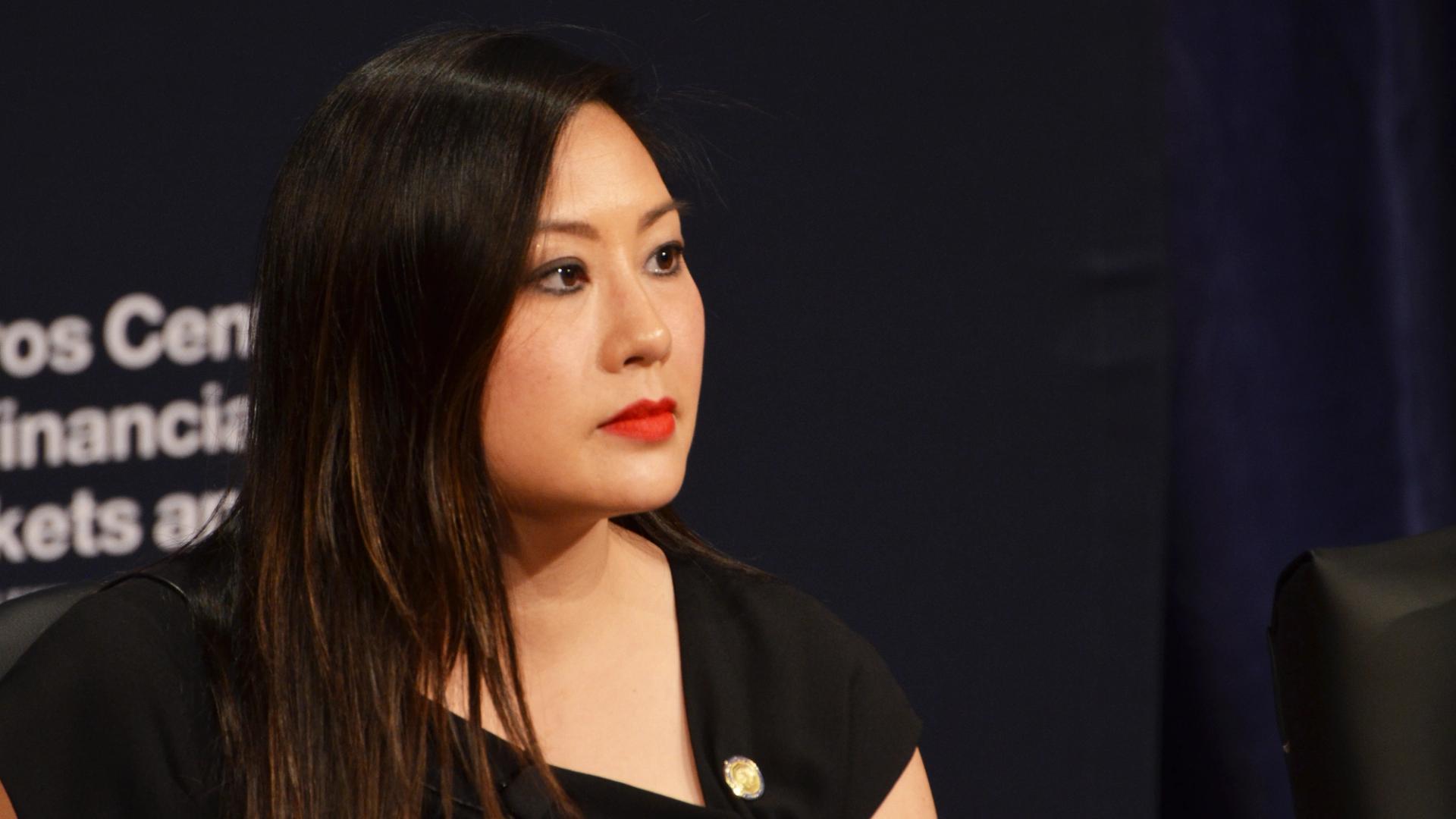Uncategorized
Haliey Welch’s $HAWK Shows Why We Need Better Standards for Memecoins

Haliey Welch, widely recognized as “Hawk Tuah,” transformed her fleeting viral fame into a formidable media empire. With a burgeoning social media presence (<a href=»https://www.instagram.com/hawktuah_/?hl=en» target=»_blank»>230K followers on Instagram</a>), lucrative brand partnerships, and the successful podcast Talk Tuah, Welch appeared to be transitioning from internet personality to business mogul.
That was until the 22-year-old launched her memecoin, $HAWK. Now Hawk Tuah isn’t flying so high.
$HAWK was launched on the Solana blockchain with considerable fanfare, initially skyrocketing to a <a href=»https://www.coindesk.com/markets/2024/12/04/hawk-tuah-sensation-haliey-welch-s-hawk-token-goes-live» target=»_blank»>$491 million market cap</a>. This meteoric rise was short-lived, as the coin’s valuation plummeted to <a href=»https://dexscreener.com/solana/exygvxvrvujjryo65vyuhlaccxhwyztkqa7jxqit2tvr» target=»_blank»>under $20 million</a>, according to data from DEX Screener.
The rapid decline raises questions about the project’s legitimacy and the motives behind its management. A now-deleted Twitter Spaces discussion further intensified suspicions, leading to <a href=»https://www.bbc.com/news/articles/c89xvjkzzyvo» target=»_blank»>widespread allegations that $HAWK is nothing more than a “celebrity rugpull.”</a>
To understand what happened, it is first necessary to examine the structure and decision-making processes that seemed to have underpinned the $HAWK launch.
Launching a memecoin might seem like a walk in the park (anyone can do it on Pump.fun). But doing it successfully is much harder. It requires capital, marketing and technical expertise alongside something good in the first place. You need teamwork. I say this as a founder who’s been in Web3 since 2013, has raised tens of millions of dollars in venture capital for projects of my own, and is a venture capitalist at a large venture fund, Foresight Ventures. (For more on how to launch a memecoin, see my other recent <a href=»https://www.coindesk.com/opinion/2024/12/12/memecoins-are-not-easy-money» target=»_blank»>CoinDesk article here</a>). $HAWK seems to have had three distinct teams behind it, according to internet sleuth <a href=»https://x.com/coffeebreak_YT?ref_src=twsrc%5Egoogle%7Ctwcamp%5Eserp%7Ctwgr%5Eauthor» target=»_blank»>Coffeezilla</a>:
Welch’s Web2 team, responsible for her “traditional” brand
<a href=»https://x.com/kbwofficial/status/1829866733743849600″ target=»_blank»>Memetic Labs, led by founder Doc Hollywood</a>, managing blockchain-related activities and holding the pen on all Web3 related decisions
and <a href=»https://x.com/overHere_gg» target=»_blank»>overHere</a>, a new technical service provider specifically brought in to facilitate a novel token claim process designed to onboard Welch’s Web2 audience.
OverHere initially engaged in discussions with me to provide context about its role and said it was open to providing anything more in a transparent manner.
In a since deleted X Spaces, Welch abruptly dropped off around 1:00am EST, telling listeners she was going to sleep. Doc Hollywood dominated the conversation. His company Memetics Labs was responsible for critical aspects of the token release, such as tokenomics, token minting and distribution, marketing (e.g. messaging over primary mediums such as X), liquidity pool creation, and trading fee settings.

One listener asked why the trading fees on Meteora were so high (Meteora is a decentralized exchange, or DEX, where users can trade cryptocurrencies directly, without middlemen.) Doc Hollywood said many of the expenses were related to costs associated with overHere’s team, as well as costs associated with setting up the foundation in the Cayman Islands. A claim partly refuted by overHere, who maintains it built the tech pro bono.
According to various industry sources who were made aware of the product’s only recent development, the social token utility technology overHere built had a new conceptual-business model. It’s one that would tokenize likeness and intellectual property tied to Web2 fans. And it’s not something that has existed in prior memecoin launches, let alone any crypto project.
Welch’s team, likely on the advice of Web3 adviser Memetic Labs, implemented exorbitant pool fees of 15% on Meteora, a decision that drew criticism from overHere when I first contacted on December 4. It seemed to maximize short term profits at the expense of the trust of both Welch’s existing Web2 community, as well as the Web3 community she hoped to expand into with this launch. High trading fees undermine the project’s credibility.
Another point of contention: the sale of millions of tokens post-launch by pre-sale investors, who were granted unrestricted access to vest their tokens. This effectively diluted the token’s value and raised suspicions of insider manipulation.
OverHere maintained its involvement was devoid of financial incentives, claiming no profits from Meteora or the pre-sale, and no access to free tokens. It described its focus as establishing $HAWK as a pioneering case study for leveraging intellectual property in token launches. However, the project’s trajectory, shaped by decisions from Welch’s Web3 team, was marred by mismanagement and missteps that made that impossible.
A lack of transparency emerges as the most significant failing in the $HAWK saga. The absence of a publicly disclosed tokenomics and distribution plan prior to the launch gave rise to accusations that the team was insider-dealing. Critics used <a href=»https://x.com/bubblemaps/status/1864439521523196046″ target=»_blank»>BubbleMaps, an auditing tool for DeFI and NFTs, to claim that 96% of the tokens were allegedly allocated to the “team.”</a> overHere later said <a href=»https://x.com/overHere_gg/status/1864503127019540912″ target=»_blank»>the actual distribution</a> for “the team” was 10%, which includes allocations for the community fund, reserves, and strategic purposes.
<a href=»https://x.com/overHere_gg/status/1864503127019540912″ target=»_blank»>According to overHere’s understanding</a>, the Web3 team — which maintained sole deployer wallet access — has denied selling these tokens. In reality, it appears this selling pressure originated from certain pre-sale investors whose involvement was never publicly disclosed prior to the launch. The initial confusion underscores a failure in communication and transparency from the outset.

Another issue was lock and vesting mechanisms were not immediately implemented, but this delay stemmed from technical bugs within the vesting protocol. All discussions regarding the token’s lock and vesting schedules were managed by Welch’s Web3 team in collaboration with Magna, the service provider overseeing these mechanisms. OverHere was intentionally uninvolved in these decisions, emphasizing its role as a technical service provider rather than an operational team. It has expressed a willingness to provide extensive documentation to clarify its position and responsibilities.
<a href=»https://x.com/jarxiao/status/1865111353318609150″ target=»_blank»>Industry experts such as Ellipsis’ Jarry Xiao</a> have said they didn’t think Welch’s team(s) had “malicious intent (this was clearly not their desired outcome). But without evidence to the contrary, this appears to be a blatant cash grab without any consideration of the consequences to retail.”
The story is a stark reminder of the perils inherent in merging celebrity influence with the nascent and often unregulated cryptocurrency market. The promise of decentralized finance funding media empires without traditional equity sales is alluring, yet $HAWK exposes the fragile foundation upon which such ventures are built. The lack of transparency, accountability, and ethical oversight can swiftly transform a promising project into a cautionary tale.
$HAWK is a testament to the critical need for robust governance frameworks and unwavering transparency in Web3 initiatives. As the team endeavors to rebuild trust and redefine $HAWK’s purpose, we, the crypto industry, must heed this lesson: without clear accountability and open communication, even the most promising projects are susceptible to collapse. We need to embed transparency and accountability at the core of all Web3 projects, particularly those of high-profile personalities who can just as easily become victims of exploitation.
Uncategorized
Mike Novogratz’s Galaxy Digital Swaps $100M ETH for SOL, On-Chain Data Shows

Mike Novogratz’s Galaxy Digital has apparently swapped $100 million worth of ether (ETH) for solana’s SOL.
According to Wu Blockchain, on-chain data suggests that Galaxy has swapped out a considerable amount of its ETH holdings for SOL. Over the last two weeks, Galaxy has transferred 65,600 ETH – or about $105 million – to Binance and has withdrawn 752,240 SOL (approximately $98.37 million).
Galaxy may have made the move because ETH continues to be in «structural decline» according to a recent note from Standard Chartered, which slashed its year-end target price for the asset.
Data from an Arkham dashboard shows that the firm holds $87.9 million ETH versus $23.86 million SOL.
Galaxy did not immediately return a request for comment from CoinDesk.
Market data shows that in the last month, SOL is up 8% while ETH is down nearly 20%.

Standard Chartered estimated in its note that Base has cut $50 billion from its market cap, but also argued that tokenized real-world assets could help stabilize Ethereum.
Many blockchain metrics would support Standard Chartered’s thesis, as transactions on Solana have rocketed past Ethereum in the last three months.

A Dune dashboard shows that decentralized exchange (DEX) volume on Solana has moved past $500 billion in the last three months, while DEX volume on Ethereum is less than $400 billion. Active addresses on Solana are over 220 million while Ethereum and Ethereum Layer-2 addresses are just over 80 million.
One idea, first proposed by Tron’s Justin Sun, to reverse this «structural decline» of Ethereum has been a tax on Layer-2s.
«All collected taxes will be used to repurchase ETH and burn it in a fully decentralized manner,» he wrote on X. This idea, however, hasn’t been formalized into an Ethereum Improvement Proposal (EIP) which would be the first step in it becoming reality.
Meanwhile, flow data from the Ether ETFs shows that investors moved nearly $600 million out of these listed products over the last two months.
Uncategorized
U.S. Derivatives Watchdog Weighs 24/7 Action With Crypto Oversight on Horizon

Bitcoin is the crypto sector’s top asset and is also universally defined by U.S. regulators and courts as a commodity, putting it under the jurisdiction of the Commodity Futures Trading Commission. That agency is now seeking public comments on whether it should open the wider world of derivatives to around-the-clock trading, as already executed for bitcoin and other digital assets.
Though the CFTC is expected to be established as a crypto market regulator in Congress’ ongoing effort to establish industry rules, the agency’s invitation for comments issued on Monday doesn’t explicitly discuss digital assets oversight. The request notes that «technological advancements and market demand» are pushing CFTC-regulated firms toward being able to handle transactions at all times.
“As I have long said, the CFTC must take a forward-looking approach to shifts in market structure to ensure our markets remain vibrant and resilient while protecting all participants,” said Acting Chairman Caroline Pham, in a statement. She was tapped by President Donald Trump to run the agency while it awaits the Senate confirmation of its chairman nominee, Brian Quintenz.
Trading without downtime presents a host of challenges for U.S. markets unaccustomed to it, according to the request, including «what governance frameworks, exchange staffing models and technologies would be necessary to ensure market integrity and operational resilience, as well as compliance with all core principles, under a continuous trading model.» Such an expansion would require firms to handle live maintenance and technology patches and human monitoring of the systems and markets during the extended hours, which are issues already long wrestled with by digital assets operations.
The CFTC would still need a change in law before it could have direct authority over actual spot-market trading of bitcoin and other tokens that aren’t eventually categorized as securities, which would get Securities and Exchange Commission oversight. If the agency is ultimately a major regulator of trading and of the platforms and firms that handle customers’ transactions, that’s a space in which 24-hour, seven-days-a-week activity is already the model.
Uncategorized
Can Bitcoin Benefit From Trump Firing Powell? Turkey’s Lira Crisis May Provide Clues

The week has begun on an interesting note, with the U.S. dollar crashing to three-year lows alongside losses on Wall Street, yet bitcoin, which usually follows the sentiment on Wall Street, stands tall.
This could just be the beginning.
The shift away from the USD and toward seizure and censorship-resistant assets like BTC and stablecoins could accelerate if President Donald Trump follows through with his reported plans to fire Federal Reserve Chairman Jerome Powell, which have pushed the DXY and U.S. stock markets lower today.
That’s the lesson from Turkey, which has seen its currency, the lira (TRY), collapse over the years mainly due to President Recep Tayyip Erdogan’s repeated interference in the central bank’s operations. The sliding lira has triggered a capital flight into BTC and stablecoins since at least 2020-21.
Trump’s issues with the Fed
Trump has feuded publicly with the Federal Reserve and its chairman, Jerome Powell, for years, criticizing Powell for being too late on rate cuts even during his first term when interest rates were way lower than today.
However, Trump’s criticism has recently reached a fever pitch with reports suggesting he is looking for ways to get rid of Powell, who recently warned of stagflation even as the President reiterated calls for lower borrowing costs while suggesting there is no inflation.
Powell’s patient approach follows a trade war-led spike in survey-based measures of inflation expectations, which could always become self-fulfilling.
Still, on Monday, Trump went further, calling Powell a «major loser» and warning that the economy could slow down unless interest rates are immediately lowered.
Lesson From Turkey
Erdogan began interfering in the central bank’s operations in 2019, and since then, the lira has collapsed sevenfold from 5.3 per dollar to 38 per dollar.
It all started with Turkey’s inflation rate reaching double digits in 2017. It remained elevated in the subsequent year, which prompted the country’s central bank to increase the one-week repo rate from 17.5% to 24% in September 2018.
The move likely didn’t go well with Erodgan, who issued the first decree dismissing Central Bank of Turkey (CBT) governor Murat Cetinkaya in July 2019. From then on until the end of 2021, Erdogan issued multiple decrees dismissing and hiring several CBT officials. Amid all this, inflation remained elevated, and the lira continued to depreciate at an alarming rate.
«We certainly don’t believe in high interest rates. We will pull down inflation and exchange rates with low-rate policy … High rates make the rich richer, the poor poorer. We won’t let that happen,» Erdogan said in 2021.
As of 2025, Turkey faces an inflation rate of nearly 40%, according to data source TradingEconomics.
This episode serves as a cautionary tale for Trump, highlighting that tampering with central bank independence — especially in the face of looming inflation — can erode investor confidence and send the domestic currency into a tailspin.
This does not necessarily mean that the USD will crash exactly like lira but may see significant devaluation.
Perhaps it could prove even more destabilizing for global markets, considering the dollar is a global reserve currency, and the U.S. Treasury market is the bedrock for international finance.
If better sense fails to prevail, U.S. investors may feel incentivized to move away from U.S. assets and into BTC and other alternative investments, just as Turks did.
-

 Fashion6 месяцев ago
Fashion6 месяцев agoThese \’90s fashion trends are making a comeback in 2017
-

 Entertainment6 месяцев ago
Entertainment6 месяцев agoThe final 6 \’Game of Thrones\’ episodes might feel like a full season
-

 Fashion6 месяцев ago
Fashion6 месяцев agoAccording to Dior Couture, this taboo fashion accessory is back
-

 Entertainment6 месяцев ago
Entertainment6 месяцев agoThe old and New Edition cast comes together to perform
-

 Sports6 месяцев ago
Sports6 месяцев agoPhillies\’ Aaron Altherr makes mind-boggling barehanded play
-

 Business6 месяцев ago
Business6 месяцев agoUber and Lyft are finally available in all of New York State
-

 Entertainment6 месяцев ago
Entertainment6 месяцев agoDisney\’s live-action Aladdin finally finds its stars
-

 Sports6 месяцев ago
Sports6 месяцев agoSteph Curry finally got the contract he deserves from the Warriors





